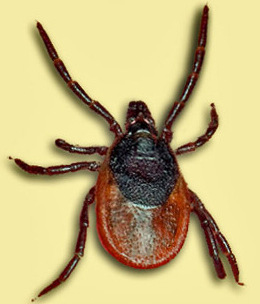Ixodes persulcatus
Ixodes persulcatus, commonly known as the Taiga tick, is a species of tick belonging to the family Ixodidae. This tick species is primarily found in the forested areas of Russia, Northern China, and Japan, and is known for being a vector of various diseases, including Lyme disease, tick-borne encephalitis (TBE), and others. The presence of Ixodes persulcatus in these regions poses significant health risks to humans and animals, making understanding its behavior, lifecycle, and control measures crucial.
Description[edit | edit source]
Ixodes persulcatus ticks are small arachnids, with adults typically measuring between 3.5 to 4.5 mm in length. They exhibit sexual dimorphism, with females generally larger than males. These ticks have a hard shield (scutum) and are distinguishable by their long mouthparts, which they use to attach to hosts for blood meals. The coloration of Ixodes persulcatus can vary from reddish-brown to dark brown.
Lifecycle[edit | edit source]
The lifecycle of Ixodes persulcatus consists of four stages: egg, larva, nymph, and adult. This tick requires a blood meal at each stage after hatching to develop into the next stage. The lifecycle from egg to adult can take up to three years, depending on environmental conditions such as temperature and humidity. Ixodes persulcatus is a three-host tick, meaning it typically feeds on three different hosts throughout its lifecycle, starting with small mammals and birds as larvae and nymphs, and often moving to larger mammals, including humans, as adults.
Habitat[edit | edit source]
Ixodes persulcatus is primarily found in the taiga and forest-steppe zones of Eurasia. They prefer humid environments and are often found in dense forests with thick underbrush, where they can easily find hosts and maintain the moisture levels necessary for their survival.
Disease Transmission[edit | edit source]
Ixodes persulcatus is a significant vector for the transmission of pathogens that cause diseases in humans and animals. The most notable diseases spread by this tick include:
- Lyme disease: Caused by the bacterium Borrelia burgdorferi, Lyme disease can lead to a range of symptoms, from rash and flu-like symptoms to more severe neurological and cardiac issues.
- Tick-borne encephalitis (TBE): A viral infection that can lead to encephalitis, an inflammation of the brain. TBE can be severe and even fatal in some cases.
- Other diseases: Ixodes persulcatus can also transmit other pathogens, including those responsible for human granulocytic anaplasmosis (HGA) and babesiosis.
Prevention and Control[edit | edit source]
Preventing tick bites is crucial in areas where Ixodes persulcatus is prevalent. Measures include using insect repellents, wearing protective clothing, and avoiding known tick habitats during peak activity periods. For those living in or visiting endemic areas, vaccination against tick-borne encephalitis is recommended. Controlling tick populations through environmental management, such as reducing brush and leaf litter where ticks may reside, is also effective.
Conclusion[edit | edit source]
Ixodes persulcatus plays a significant role in the transmission of diseases in its endemic regions. Understanding its lifecycle, habitat, and the diseases it can transmit is essential for prevention and control efforts. Ongoing research and public health initiatives are crucial to mitigate the risks associated with this tick species.
Translate: - East Asian
中文,
日本,
한국어,
South Asian
हिन्दी,
தமிழ்,
తెలుగు,
Urdu,
ಕನ್ನಡ,
Southeast Asian
Indonesian,
Vietnamese,
Thai,
မြန်မာဘာသာ,
বাংলা
European
español,
Deutsch,
français,
Greek,
português do Brasil,
polski,
română,
русский,
Nederlands,
norsk,
svenska,
suomi,
Italian
Middle Eastern & African
عربى,
Turkish,
Persian,
Hebrew,
Afrikaans,
isiZulu,
Kiswahili,
Other
Bulgarian,
Hungarian,
Czech,
Swedish,
മലയാളം,
मराठी,
ਪੰਜਾਬੀ,
ગુજરાતી,
Portuguese,
Ukrainian
Navigation: Wellness - Encyclopedia - Health topics - Disease Index - Drugs - World Directory - Gray's Anatomy - Keto diet - Recipes
Search WikiMD
Ad.Tired of being Overweight? Try W8MD's physician weight loss program.
Semaglutide (Ozempic / Wegovy and Tirzepatide (Mounjaro) available.
Advertise on WikiMD
WikiMD is not a substitute for professional medical advice. See full disclaimer.
Credits:Most images are courtesy of Wikimedia commons, and templates Wikipedia, licensed under CC BY SA or similar.Contributors: Prab R. Tumpati, MD

